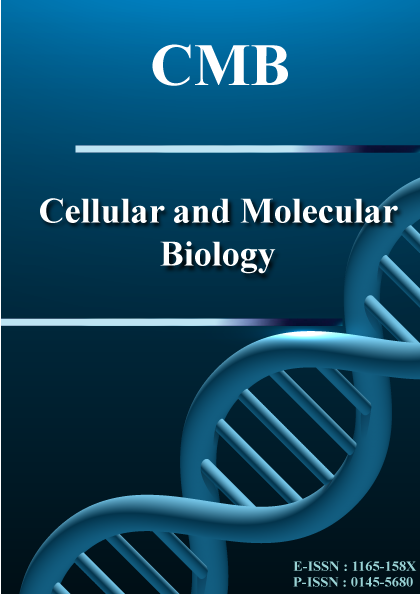Issue
Copyright (c) 2025 Abu Bakar Mohammad Sharif Hossain, Mekhled M Alenazi, Danial Kahrizi

This work is licensed under a Creative Commons Attribution-NonCommercial-NoDerivatives 4.0 International License.
The undersigned hereby assign all rights, included but not limited to copyright, for this manuscript to CMB Association upon its submission for consideration to publication on Cellular and Molecular Biology. The rights assigned include, but are not limited to, the sole and exclusive rights to license, sell, subsequently assign, derive, distribute, display and reproduce this manuscript, in whole or in part, in any format, electronic or otherwise, including those in existence at the time this agreement was signed. The authors hereby warrant that they have not granted or assigned, and shall not grant or assign, the aforementioned rights to any other person, firm, organization, or other entity. All rights are automatically restored to authors if this manuscript is not accepted for publication.Effects of naphthalene acetic acid on aborted okra production, antioxidants, minerals, phenol, flavonoid, and carotenoid content applied to flower ovary stigma
Corresponding Author(s) : Abu Bakar Mohammad Sharif Hossain
Cellular and Molecular Biology,
Vol. 71 No. 4: Issue 4
Abstract
The experiment was carried out to investigate the effect of different concentrations of NAA (naphthalene acetic acid) on the seedless (aborted) okra production, vitamin C, carotenoids, flavonoids, antioxidants (DPPH), phenolic, and mineral content. The micro-syringe injection in flower stigma was an innovative application method used in this experiment, rather than spray, which was a common and traditional method. The flower stigma injection method was applied on the flower stigma after the anthesis of the flower of the okra plant using NAA at different concentrations. In Experiment 1: The lowest concentration (25 mg/l) of NAA greatly increased the pod setting compared to the higher concentrations and control. NAA application at 25 and 50 mg/l concentrations induced higher values of pod length, diameter, size, weight, ascorbic acid, and soluble solid content over the control. The chlorophyll content in leaves was affected significantly by different concentrations of NAA. It was found that 25 and 50 mg/l concentrations of NAA significantly increased chlorophyll content, fiber, moisture, flavonoid, carotenoid, antioxidant (DPPH), minerals, and phenolic content compared to the other concentrations and control. In addition to that, control and 25 mg/l concentrations of NAA increased the production of healthy seeds compared to the 50 and 100 mg/l. Moreover, 50 and 100mg/l of concentrations showed higher aborted seed (seedless) than the other concentration and control. In Experiment 2: In the second year, the residual effects of aborted seed (seedless) were found to have a decreasing trend of most of the parameters like pod weight, size, aborted okra percent, leaf chlorophyll, antioxidant (DPPH), and Vitamin C. But, NAA concentrations showed better residual effects in the second year in comparison to the control. Therefore, it seemed that 25 mg/l was the best concentration for pod growth and development, and 100 mg/l was the best for seedless okra production in the first and second years.
Keywords
Download Citation
Endnote/Zotero/Mendeley (RIS)BibTeX




